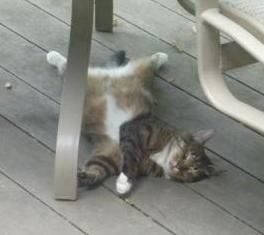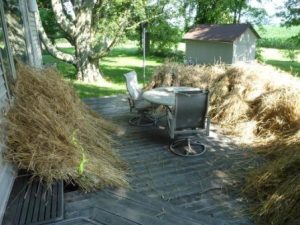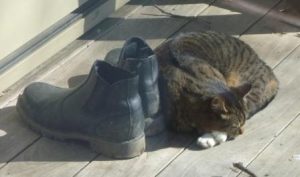This is the first in what will be an on-going series describing the (mis)adventures my husband and I have on our 5-acre mini-farm. Most people agree that it’s pretty easy to grow your own vegetables (even year round) and other grains, but some might think that growing fresh, local, sustainable, and organic cat food is impossible. Nonsense, I say! You can grow your own cat food. We’ve done it with great success. Here is the detailed step-by-step guide:
- Have a cat ready. Here is ours, affectionately known as Fuzzy.

- Till up enough land to grow about 1/8 acre of wheat. We chose a variety of heritage wheat strains that we had grown up from a handful of wheat heads until we had enough seed for a large planting.
- Plant your wheat seed. We started out using our Hoss Tools seed planter (which is fabulous in the garden) with a custom seed plate, but determined it was going to take approximately forever because the seedbed was not fine enough. We ended up using a fertilizer drop spreader as a backup and drove over it with our mower to tamp the seed down.
- Watch your wheat grow with excitement, and then later, with perhaps a tiny bit of dread.
- Check your wheat by biting a grain to see if it’s the “soft-dough” stage … kinda chewy and a little moist.
- Prepare to harvest your wheat. Call a bunch of your friends to see if they would enjoy an afternoon in the broiling heat and sun and dust while picking up wheat and binding it into shocks. Be amazed at the awesomeness of your friends when you get some takers (Thanks Amanda, Lori, and Kristin!!).
- Bring out your BCS 2-wheel tractor with the 5-foot sickle bar mower attachment (awesome!). Cut down the wheat in very little time.
- Gather and bind the wheat (watch out for any nettles that might be mixed in) and color-code the shocks by wheat type. This takes some time.

- Stack the wheat on the deck.
- Attempt to thresh some of the wheat in your home-made threshing machine. Be discouraged when those very long and sturdy heritage wheat stalks bind up the machine. Decide the wheat needs to dry out a bit more.
- Look frantically around for somewhere to store the wheat to allow it to dry. Recall the wood shed you recently had built, with strict instructions to the contractors to make it mouse-proof (or at least highly mouse-resistant).
- Place wheat in wood shed.
- Wait.
- Realize after some time that the mouse-proofing was not quite as good as advertised … mice can get in, but they can’t easily get out (and really … why would they want to .. they have all that lovely organic heritage wheat to eat).
- Be somewhat amazed to learn that you have your very own mouse CAFO (confined animal feeding operation) in your wood shed.
- Clean out the shed and burn what remains of your beautiful mouse-soaked wheat.
- Allow your cat to grow fat on the bumper crop of fresh, local, organic, grain-finished mice you have provided for her. Voila! Cat food!



